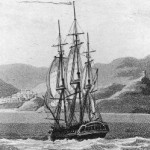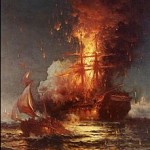 Citizens of Timbuktu, Mali’s historic city and the legendary UNESCO World Heritage Site, are rallying to protect ancient documents dating back to the Golden Age of the 12th and 15th centuries that officials fear may be looted or trafficked under the current occupation by Tuareg groups. United Nations Educational, Scientific and Cultural Organisation (UNESCO) Director-General Irina Bokova on Tuesday (April 17th) appealed to Mali’s neighbours to help prevent any looting or destruction of Timbuktu’s centuries-old cultural heritage: “Reports about the rebel takeover of Timbuktu’s Ahmed Baba Institute of Higher Islamic Studies and Research (IHERI-AB) and other cultural institutions are cause for great alarm.” “These centres contain ancient documents, written or copied locally, and others written in Morocco, Andalusia or some African countries, or sent to Timbuktu by pilgrims from distant Islamic lands hundreds of years ago,” Bokova added. These documents, she said, date back to “Timbuktu’s golden period of glory between the 12th and 15th centuries” and cover subjects “from religious studies to mathematics, medicine, astronomy, and music”.
Citizens of Timbuktu, Mali’s historic city and the legendary UNESCO World Heritage Site, are rallying to protect ancient documents dating back to the Golden Age of the 12th and 15th centuries that officials fear may be looted or trafficked under the current occupation by Tuareg groups. United Nations Educational, Scientific and Cultural Organisation (UNESCO) Director-General Irina Bokova on Tuesday (April 17th) appealed to Mali’s neighbours to help prevent any looting or destruction of Timbuktu’s centuries-old cultural heritage: “Reports about the rebel takeover of Timbuktu’s Ahmed Baba Institute of Higher Islamic Studies and Research (IHERI-AB) and other cultural institutions are cause for great alarm.” “These centres contain ancient documents, written or copied locally, and others written in Morocco, Andalusia or some African countries, or sent to Timbuktu by pilgrims from distant Islamic lands hundreds of years ago,” Bokova added. These documents, she said, date back to “Timbuktu’s golden period of glory between the 12th and 15th centuries” and cover subjects “from religious studies to mathematics, medicine, astronomy, and music”.
 Moussa Ag Hamta, owner of a private library, told Magharebia that the concerns of the UNESCO Director-General were shared by the residents of Timbuktu who link their history to these historical centres.
Moussa Ag Hamta, owner of a private library, told Magharebia that the concerns of the UNESCO Director-General were shared by the residents of Timbuktu who link their history to these historical centres.
“I’m proud of the documents I own because they contain many sciences,” he said. “However, the takeover of the city by the extremist Islamic groups has put an end to the arrival of European tourists and made me hide these documents lest I should be forced to destroy or turn them in to them.” “They consider these documents to be a heresy and believe that preserving them is some sort of worship, which contradicts the Islamic Sharia in their opinion,” he concluded.
 Local resident Ibrahim Ag Nita described the scene: “Two days ago, some Ansar al-Din and al-Qaeda elements entered the Documents Centre at Ahmed Baba Institute and told the attendees that the Islamic Sharia only approves of Islamic religious books because they help boost doctrine, and that books of other sciences, such as math, astronomy and other sciences, are not useful to Muslims and must be removed.”
Local resident Ibrahim Ag Nita described the scene: “Two days ago, some Ansar al-Din and al-Qaeda elements entered the Documents Centre at Ahmed Baba Institute and told the attendees that the Islamic Sharia only approves of Islamic religious books because they help boost doctrine, and that books of other sciences, such as math, astronomy and other sciences, are not useful to Muslims and must be removed.”
“After that, they took away rubber bags containing some documents and went to an unknown place,” he said.
“People here fear a repetition of what the Taliban did when it destroyed some Buddha statues as idols worshipped by people,” he added. “This is the same view that these extremists have of human heritage, as they say that this entire heritage is nothing but a heresy that must be disposed of.”
 Timbuktu has been a destination for cultural tourism in recent years, as it contains between 60,000 and 100,000 manuscripts. This is in addition to mosques and shrines of the kings of Sudanese empires that inhabited the Sahara and West Africa, together with buildings dating back to several centuries.
Timbuktu has been a destination for cultural tourism in recent years, as it contains between 60,000 and 100,000 manuscripts. This is in addition to mosques and shrines of the kings of Sudanese empires that inhabited the Sahara and West Africa, together with buildings dating back to several centuries.
_________________________________________________________________________________________________

__________________________________________________
Even people who have never heard of Mali have usually heard of Timbuktu, or at least have heard phrases like “from here to Timbuktu.” Founded between the 5th and 11th centuries by Tuareg desert nomads, Timbuktu became a meeting point between north, south and west Africa and a melting pot of black Africans, Berber, Arab and Tuareg desert nomads. The trade of gold, salt, ivory and books made it the richest region in west Africa and it attracted scholars, engineers and architects from around Africa, growing into a major centre of Islamic culture by the 14th century. Timbuktu is home to nearly 100,000 ancient manuscripts, some dating to the 12th century, written in Arabic or Africanized versions of the Arabic alphabets, and preserved in family homes and private libraries under the care of religious scholars. However, the city is poor now, and is at the center of attacks by Tuareg rebels and al-Qaeda linked jihadists, while Mali itself is being governed by the head of a botched military coup. It’s feared that the violence will lead to the destruction of the manuscripts and Timbuktu’s great earthen architectural wonders.
Source:AFP
_________________________________________________________
More about the Timbuktu manuscripts [with different figures: “700,000 medieval African documents”] http://en.wikipedia.org/wiki/Timbuktu_Manuscripts
_________________________________________________________
The Tombouctou Manuscripts Project
The Tombouctou Manuscripts Project at the University of Cape Town (UCT) is dedicated to research various aspects of writing and reading the handwritten works of Timbuktu and beyond. Training young researchers is an integral part of its work.
Sauvegarde et Valorisation des Manuscrits pour la Défense de la Culture Islamique
NEWS:
– TF1 News (12 avril 2012) : http://lci.tf1.fr/filnews/monde/nord-mali-les-islamistes-controlent-le-plus-grand-centre-de-manuscrits-7129513.html
– Jeune Afrique (11 avril 2012) :http://www.jeuneafrique.com/Article/ARTJAWEB20120411115235/culture-rebelle-tombouctou-manuscritmali-d-importants-manuscrits-anciens-de-tombouctou-sauves-de-la-destruction.html
– Rue89 (Le Nouvel observateur) (10 avril 2012) http://www.rue89.com/2012/04/10/tombouctou-un-tresor-culturel-de-lhumanite-en-peril-231031
________________________________________________________
Interest in ancient books could restore Timbuktu
http://www.washingtonpost.com/wp-dyn/content/article/2010/01/04/AR2010010403161.html?hpid=artslot
By Karin Brulliard
Washington Post Foreign Service
Tuesday, January 5, 2010; A07
TIMBUKTU, MALI — From a dented metal trunk, Abdoul Wahim Abdarahim Tahar pulled out something sure to make a preservationist’s heart race — or break: a leather-bound book written by hand in the 14th century, containing key verses of the prophet Muhammad, and crumbling at the edge of each yellowed page.
“Every time I touch it, it falls apart,” he said, paging through the book. “Little by little.”
But Tahar saw promise in the brittle volume — for himself, his family and this legendary but now tumbledown town. He is not the only one. A sort of ancient-book fever has gripped Timbuktu in recent years, and residents hope to lure the world to a place known as the end of the Earth by establishing libraries for visitors to see their centuries-old collections of manuscripts.
In a West African town where nomads and traders eke out livings, a revival of world attention to hundreds of thousands of privately held manuscripts — which survived fire, rain, sand and termites — represents an economic opportunity. But researchers and residents say the restoration of the books, most written in Arabic on fragile paper or lambskin, is also vital to showcasing Timbuktu’s — and, by extension, sub-Saharan Africa’s — more glorious past as a vibrant hub of scholarship.
—
[MORE] … http://www.washingtonpost.com/wp-dyn/content/article/2010/01/04/AR2010010403161.html?hpid=artslot
________________________________________________________
On Apr 10, 2012, at 9:42 PM, “Jennifer Yanco” <1989.wara@gmail.com> wrote:
I am writing to alert you to the situation in Mali, which is increasingly volatile. The conflict has spread to Timbuktu, home of thousands of manuscripts documenting the rich heritage of West Africa through the ages.
I write as a member of the scholarly community, which is concerned for the safety of this cultural and intellectual heritage housed in the many libraries and private collections in Timbuktu. I know that this will be of concern to your institution. Our West African colleagues, Drs. Habib Sy and Ibrahima Lo prepared a petition, urging the parties to the conflict to be mindful of the value of the heritage in these manuscripts and to spare them. We were sent a copy of the petition and were able to make an online petition, which you can now find on the WARA website home page (www.bu.edu/wara) and at the link copied below.
We are pleased to be able to work in solidarity with our West African colleagues on this and hope that you will be able to post the link to the petition or otherwise pass it along to your colleagues. A major treasure of the world is at stake.
http://bit.ly/TIMBUKTU
thanking you in advance for joining this effort.
Jennifer
—
Jennifer J. Yanco, PhD
US Director
West African Research Association
232 Bay State Road
Boston, MA 02215
617-353-8902
www.bu.edu/wara
 Sezgin Online : A bio-bibliography for the Arabic literary tradition – Sezgin Online consists of volumes 1-9 of Fuat Sezgin’s renowned Geschichte des arabischen Schrifttums (GAS), the largest and most modern bio-bibliography for the Arabic literary tradition in general and the history of science and technology in the Islamic world in particular.
Sezgin Online : A bio-bibliography for the Arabic literary tradition – Sezgin Online consists of volumes 1-9 of Fuat Sezgin’s renowned Geschichte des arabischen Schrifttums (GAS), the largest and most modern bio-bibliography for the Arabic literary tradition in general and the history of science and technology in the Islamic world in particular.

















